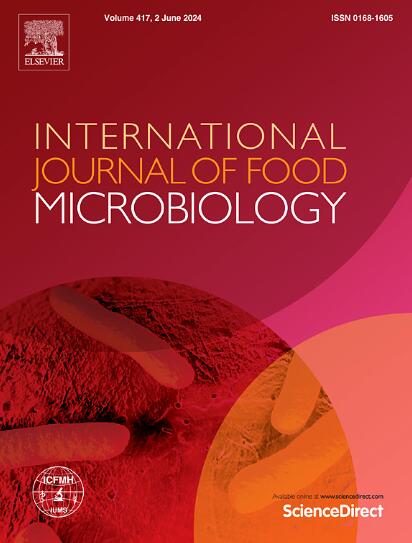Unraveling Hepatitis E Virus susceptibility to heat treatment, pH reduction and drying in pork meat
IF 5
1区 农林科学
Q1 FOOD SCIENCE & TECHNOLOGY
International journal of food microbiology
Pub Date : 2025-07-08
DOI:10.1016/j.ijfoodmicro.2025.111342
引用次数: 0
Abstract
Foodborne Hepatitis E virus infection, linked mainly to pork consumption, is a significant public health issue in Europe. Despite the known risk of HEV contamination in pork, the effectiveness of meat processing methods in inactivating the virus is unclear, emphasizing the need for comprehensive investigations. This study examined the impact of common meat processing practices—heating, drying, and pH reduction—on inactivation of HEV in both suspension and pork pâté and sausages.
HEV suspensions were exposed to various temperatures (94 °C, 71 °C, 61 °C for 10 min; 73 °C, 100 °C for 20 min) and pH levels (pH 6.5, 6.1, 5.5 for 7 days at 7 °C and 20 °C). Pork pâtés were heated to temperatures of 68 °C, 72 °C, 80 °C, and 99 °C, while sausages were dried for up to 14 days and acidified to pH 4.1. HEV infectivity was assessed via immunostaining and methods evaluating HEV integrity.
Thermal treatment reduced HEV viral load variably, with complete inactivation only at 99 °C (>3.5 log reduction). Drying reduced viral RNA in sausages, but intact viral particles remained for up to 14 days. pH reduction showed minimal impact on viral particle integrity. Results in suspension were consistent with those in meat matrices.
This study is among the first to demonstrate in actual meat matrices that current meat processing methods might be insufficient for eliminating intact HEV particles in high-risk products like ready-to-eat pâté and dried sausages. The findings highlight the need for more effective HEV inactivation techniques and improved food safety measures to reduce the risk of foodborne HEV infections.

揭示戊型肝炎病毒对热处理、pH值降低和猪肉干燥的敏感性
食源性戊型肝炎病毒感染主要与猪肉消费有关,是欧洲一个重大的公共卫生问题。尽管猪肉中存在已知的戊肝病毒污染风险,但肉类加工方法灭活病毒的有效性尚不清楚,这强调了进行全面调查的必要性。本研究考察了常见的肉类加工方法——加热、干燥和pH值降低——对混悬液、猪肉肉酱和香肠中戊肝病毒失活的影响。将HEV悬液暴露在不同温度下(94°C、71°C、61°C) 10分钟;73°C, 100°C 20分钟)和pH水平(pH 6.5, 6.1, 5.5在7°C和20°C下7天)。猪肉 被加热到68°C, 72°C, 80°C和99°C的温度,而香肠被干燥长达14天并酸化到pH 4.1。通过免疫染色和HEV完整性评估方法评估HEV传染性。热处理不同程度地降低了HEV病毒载量,仅在99°C时完全失活(降低3.5 log)。干燥减少了香肠中的病毒RNA,但完整的病毒颗粒可以保存长达14天。pH值降低对病毒颗粒完整性的影响最小。混悬液中的结果与肉基质中的结果一致。这项研究首次在实际的肉类基质中证明,目前的肉类加工方法可能不足以消除即食肉饼和干香肠等高风险产品中的完整HEV颗粒。这些发现强调需要更有效的戊型肝炎灭活技术和改进的食品安全措施,以减少食源性戊型肝炎感染的风险。
本文章由计算机程序翻译,如有差异,请以英文原文为准。
求助全文
约1分钟内获得全文
求助全文
来源期刊
CiteScore
10.40
自引率
5.60%
发文量
322
审稿时长
65 days
期刊介绍:
The International Journal of Food Microbiology publishes papers dealing with all aspects of food microbiology. Articles must present information that is novel, has high impact and interest, and is of high scientific quality. They should provide scientific or technological advancement in the specific field of interest of the journal and enhance its strong international reputation. Preliminary or confirmatory results as well as contributions not strictly related to food microbiology will not be considered for publication.

 求助内容:
求助内容: 应助结果提醒方式:
应助结果提醒方式:


